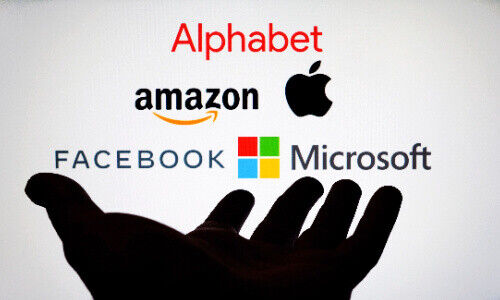The Big Tech Banking Stumble
The six largest giants in tech are exactly nowhere after years of saying they would get rid of legacy banks and shake up a staid and complacent financial industry.
It has been almost ten years since stories started appearing about how big tech would supposedly cut the financial industry down to size, eating each and every established bank out there for breakfast.
But since then, precious little seems to have happened, at least according to data released Tuesday by online publisher «Visual Capitalist» that examined the revenues of the largest six tech companies using relevant annual figures for 2022 and 2023. In fact, things seem to be shaping up to be a lost decade more than anything else.
Bookish Amazon
About five to six years ago, as an example, Amazon had been touted as one of the «digerati» that would take big pieces out of the traditional banking market, as a 2018 report by financial industry non-profit BAI indicates.
The vast proportion of Amazon’s revenues, however, remains in online stores (42.8 percent) and third-party seller services (22.9 percent).
Small Foothold
Apple, by contrast, seems to have managed to eke out and keep a small foothold with Apple Pay, which is folded into its services area along with Apple Music and Apple tv.
All three together make up only 22.2 percent of the US-based behemoth’s revenues, paling in comparison to the iPhone, which comes in at more than half of the group total, followed by wearables (10.4 percent), Mac (7.7 percent), and iPad (7.4 percent).
The Weird Move
Still, the talk of impending banking doom seems to have ebbed somewhat, with Pay seen as more threatening to fintechs than anything else when going by a «Breakingviews» article published two years ago.
So what is going on? It might be a misjudgment of the challenges posed by banking, or something as simple as the irritating contortions one occasionally makes to get a watch – or a phone – close enough to a scanner.
Unprompted Opening
It makes the effort to place a staid, yet light, credit/debit card, and the use of cash seem almost effortless in comparison, and something not helped by the constant in-app juggling between transport cards and other payment cards in the Wallet app.
Not to mention the fear of running out of battery completely on an aging, lithium-challenged smartphone, only to be left there sitting high and dry, unable to pay your way home on an Uber or a subway.
Not so Easy
All this could be hampering adoption, just as the frequent, unprompted opening of the Apple Pay wallet anywhere near the proximity of an NFC reader might be. In short, it is all not as easy as we were led to believe initially. Either that, or the industry is keeping the best for last, and we haven’t yet been hit with a new generation of bank-killing apps.
But that doesn’t seem likely right now, and, in any case, we have digressed somewhat. Alphabet, the next member of the big six, also doesn’t seem to be making much of an inroad into banking, at least not directly, with well more than half of its revenues coming from what can only be termed as legacy search activities, with the remaining roughly evenly apportioned between network services, YouTube ads, cloud services as well as the ineffable «other».
Servers and Office
Microsoft is no different. Its revenue make-up is led by server products and cloud services (37.7 percent), followed by Office products (23 percent), Windows (10.1 percent), gaming (7.3 percent, LinkedIn (7.1 percent), and four or five other areas, including Bing/search, that we will permit ourselves to call generalized stuff.
Meta isn’t even trying. Its revenues continue to be had almost exclusively (98.1 percent) from advertising on its WhatsApp, Instagram, Threads apps, as well as Facebook. That is, apart from a miniscule 1.9 percent that comes from its Reality Labs, best known for the Oculus headset.
Financial Solutions
That last of the big six, relative newcomer Nvidia, is not seen as relevant for banks, at least not directly as far as we know, although it is out there in the market providing AI-powered financial services solutions.
And therein lies a small catch. The big six seem to have changed their stance from industry killers to instead providing them with captive, barely cancellable services, mainly cloud-based ones, a concept that has been very familiar to trapped consumers for years now.
Small Bright Spot
It seems to be a small bright spot in an otherwise undifferentiated landscape. But even here, trouble broods under the hood of a good old mainframe.
A report on cloud services by the US Treasury in February this year found several startling gaps, among them insufficient transparency, security, operational resilience, and a confusing patchwork of international regulation.
Market Concentration
But more importantly, they raised significant concerns about market concentration, given that there are only «three major» cloud service providers, or CSPs - Amazon Web Services (AWS), the Google Cloud Platform (GCP) and Microsoft Azure.
But antitrust concerns are nothing new when it comes to big tech.
Numerous Cases
We had the dropped IBM case of the early 1980s, the Netscape/Microsoft browser wars in the 1990s, and the high numbers of cases floating around the world right currently.
It seems that the more things change, the more they stay the same. But now at least it seems like the financial industry, and legacy banks, are no longer directly in the cross-hairs – and that they won’t be for quite some time.























